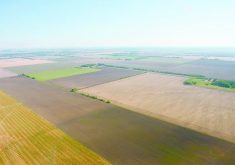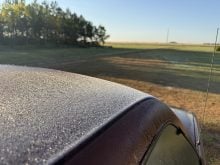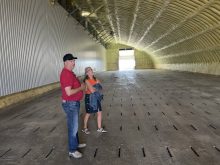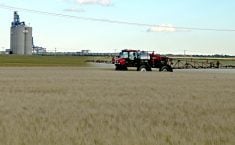Powdery mildew on field peas was a big problem in many areas in 2003. Some producers believe powdery mildew resistant varieties bought last spring did not work in the field.
“Powdery mildew is a fungal disease that affects not only field peas but also other legumes such as alfalfa, vetch, lentil and lupine,” said Ken Lopetinsky, pulse research agronomist with Alberta Agriculture in Barrhead.
“The disease overwinters on infected plant debris. The symptoms of the disease are small white spots on the upper surface of the leaves usually appearing first on the older leaves or lower portion of the plant. These spots grow together to form a white to grey powdery dust that, in a heavily infected crop, eventually turns the entire crop a light blue or grey colour.”
Read Also
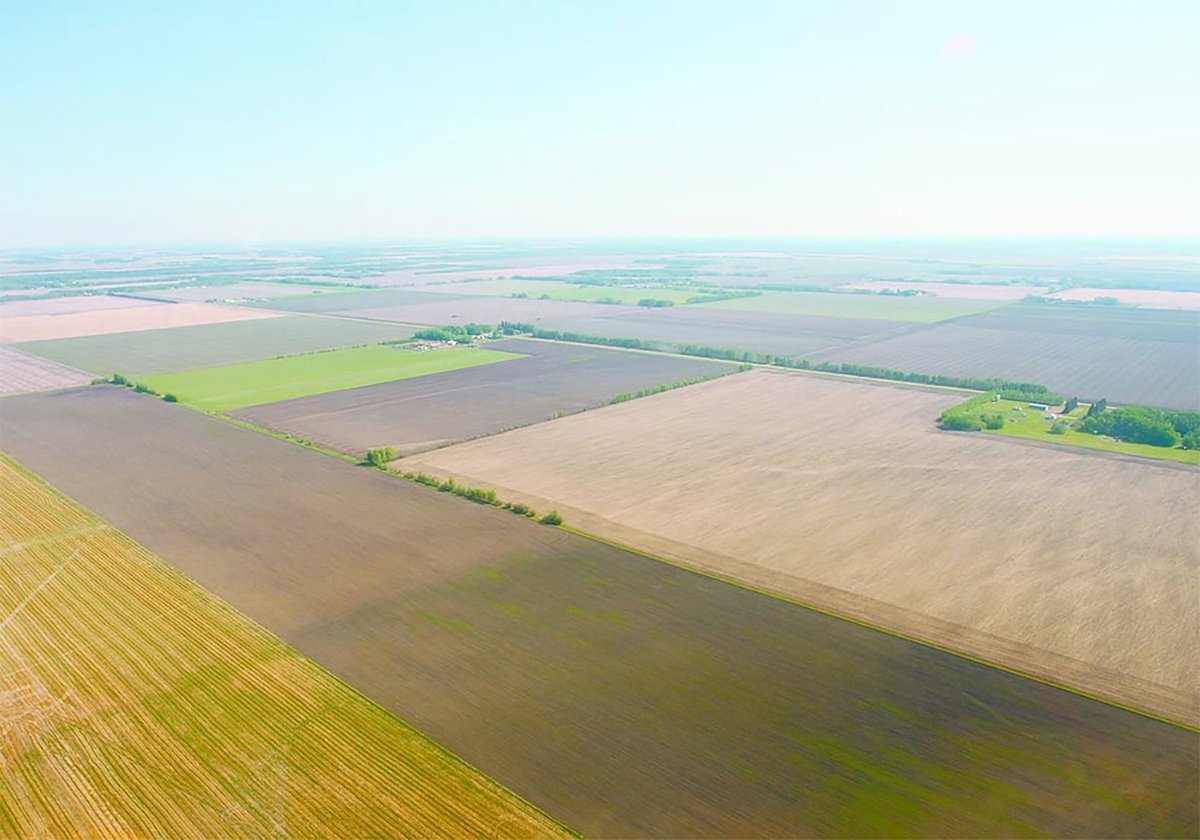
Saskatchewan amends farm land ownership regulations
The Canada Pension Plan Investment Board can no longer own Saskatchewan farmland.
The risk of disease increases with later seeding, as well as high nitrogen fields. Also, hot days followed by consecutive cool night temperatures (less than 10 C) result in rapid progress of this disease, to within four to five days. For this reason regular and frequent scouting of fields is critical.
The loss caused by powdery mildew is dependent on when the disease symptoms appear, said Mark Olson, pulse extension specialist with Alberta Agriculture’s Crop Diversification Centre North, Edmonton.
“Early infections of powdery mildew result in stunted plant growth, reduced plant weight, reduced yield or even death of the plant. Later infections will reduce the effectiveness of harvest aids such as Reglone and RoundupTransorb and loss in field pea quality, especially green types.”
Seeding early and selecting fields where nitrogen levels have been drawn down help to avoid this disease.
A sulfur-based product called Kumulusr DF is available for use on field peas. It is sprayed at first appearance of the disease and may be repeated at seven to 10 day intervals. It costs about $3 per acre, plus application cost.
Headline, or pyraclostrobin, is a new product that controls powdery mildew and ascochyta. It is sprayed at the beginning of flowering or at the onset of the disease symptoms. It may be repeated 10-14 days later if the mildew persists. It costs about $16.50 per acre, plus application cost.
“Growers should be reminded to use only those products registered on field pea for control of powdery mildew,” said Olson. “The use of unregistered products might lead to trade sanctions.”
Several varieties are resistant to powdery mildew but farmers should be aware these varieties might not have as high quality characteristics, such as bleaching resistance or stand ability, compared to non-resistant varieties.
Powdery mildew resistant yellow varieties currently or soon to be available in Alberta are CDC Golden, CDC Handel, CDC Mozart, Cutlass, DS Admiral, DS Stalwarth, Eclipse, SW Salute, Topeka and Tudor. The only green varieties resistant to powdery mildew are Stratus, Bluebird and Camry. There are also a number of registered resistant varieties no longer available or grown in Alberta.
“There are a number of theories floating around regarding what happened to the powdery mildew resistant varieties in 2003,” said Lopetinsky.
“According to plant breeders, powdery mildew resistance is inherited as a recessive trait and this inheritance is analogous to a pregnancy. That is, either you are or you aren’t. There is no such thing as being a little bit resistant to powdery mildew.
“If the powdery mildew resistant field pea you grew did not exhibit resistance and the seed purchased was not certified true to variety, it is possible that you did not receive the variety you thought you were buying.
“Another explanation might be that the non-certified seed purchased was blended off or inadvertently mixed with a susceptible variety.”
It could also be that the disease was not powdery mildew, but rather downy mildew, ascochyta blight or sclerotinia.
New cattle endectocide
Megamectin (ivermectin) Pour-On from Novartis Animal Health Canada Inc. is a new endectocide now available for Canadian cattle producers.
The product is available exclusively through veterinarians and introduces competition in the ivermectin market.
Megamectin has been approved to the same standards of other endectocides under Health Canada’s Veterinary Drugs Directorate.
When used in feedlots and cow-calf operations, Megamectin helps prevent production losses from internal parasites, lice, mites, grubs and flies. It has a 100 percent lice control guarantee.
It is available as a pour-on formulation in three ready-to-use sizes: 2.5 and five litre collapsible packs, and a 20 L container. An application gun is available with the purchase of the two larger sizes.
For more information, contact a veterinarian.
Auto-steer GPS for curves
Outback Guidance’s new eDrive is an auto-steer system guided by a global positioning system.
It works with the Outback S GPS guidance system to handle straight lines and contours.
Each system is designed to match a specific model of tractor or self-propelled sprayer. The installation guide is easy to read and has photos. Installation takes about two hours and requires no special training, the company says.
The dynamic look-ahead capability of the Outlook S base unit enables eDrive to provide high pass-to-pass accuracy, even on compound curves.
The system assesses steering action five times a second and it is capable of detecting a steering error as small as a fraction of a degree.
For more information, call 800-247-3808 or visit www.outbackguidance.com.
Liquid feed accuracy
Fancom’s PreDosator adds minerals, vitamins and supplements to liquid feed blends with precision.
The weigher’s heavy stable construction means vibrations from the feed kitchen cannot influence measurement. It measures to an accuracy of one-tenth of a gram.
It can be cleaned thoroughly with water or air after each use. Tube pumps do not come into contact with liquid so even aggressive substances such as amino acids can be added without problems.
The PreDosator control has been built into the company’s 788 feed computer.
A software update is available for existing 778 users.
For information, write to 8162 Dyke Road, Abbotsford, B.C., V4X 2G7, phone 604-856-7296, or fax 604-856-5836.




